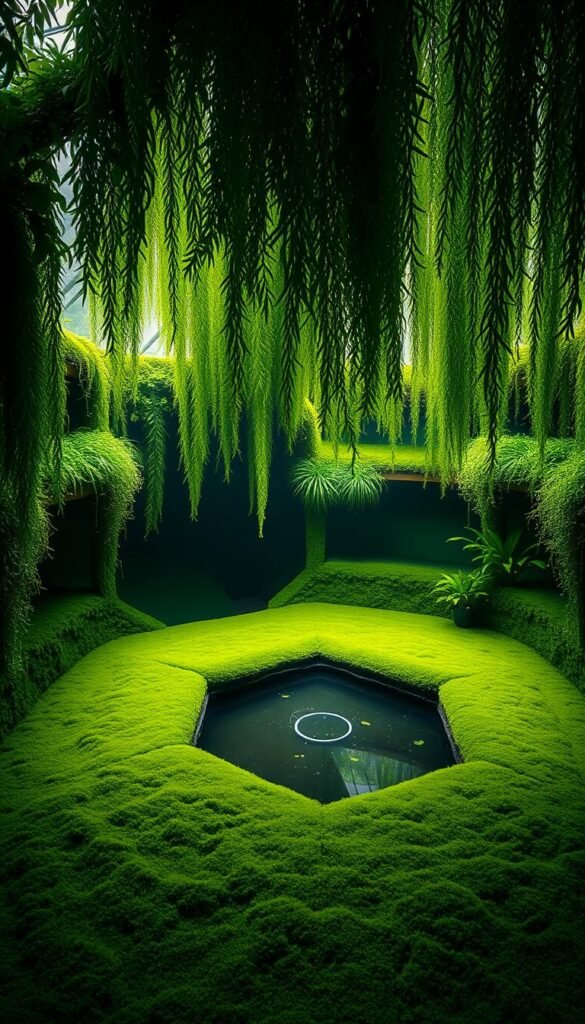Imagine transforming forgotten corners into vibrant green retreats that breathe life into any room. These living tapestries connect you with Earth’s earliest greenery—organisms that thrived long before dinosaurs roamed. Their velvety textures and soothing hues create spaces where time seems to slow down.
Unlike traditional houseplants, these delicate wonders absorb moisture through their leaves, making them ideal for areas where others wilt. Bathrooms, sunlit kitchens, or shaded nooks become perfect spots to cultivate their quiet beauty. No complex soil mixes or daily watering—just consistent humidity and indirect light keep them thriving.
This practice draws inspiration from Japanese garden design, where simplicity meets profound elegance. Each arrangement becomes a meditation on balance, inviting calm into busy modern lives. You’re not just growing plants—you’re crafting a living artwork that evolves with the seasons.
Discover how these ancient organisms can elevate your space with minimal effort. Whether you’re a seasoned plant lover or new to greenery, this approach offers fresh ways to harmonize with nature’s rhythms right at home.
Understanding the Basics of Indoor Moss Gardens
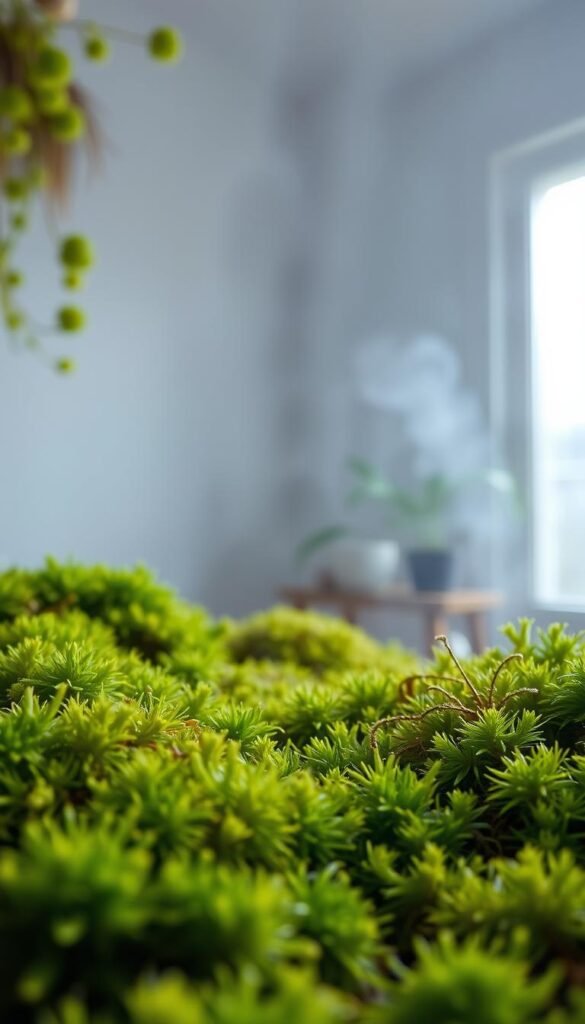
Step into a world where greenery thrives without soil or complex care. These ancient organisms—older than flowering plants—bring nature’s resilience into modern homes through their elegant simplicity.
What Makes These Plants Unique?
Unlike other houseplants, these species absorb water and nutrients through their leaves. They lack traditional roots, instead using thread-like structures called rhizoids to anchor themselves. This lets them grow on stones, wood, or even vertical surfaces.
Their reproduction fascinates biologists. Tiny spore capsules release particles that travel on air currents, creating new colonies. You might notice fuzzy patches expanding naturally in your display over time.
Crafting Calm Through Texture
The velvety surface acts like a sound absorber, softening echoes in tiled rooms. Studies show their green hues can lower stress hormones by up to 15% when viewed regularly. Your space becomes a living meditation aid.
These organisms also host beneficial microbes that filter airborne particles. A 6″x6″ patch processes as much oxygen as a small fern, making them functional art pieces. Just maintain humidity levels, and they’ll reward you with year-round vitality.
Selecting the Right Moss Species for Your Indoor Garden
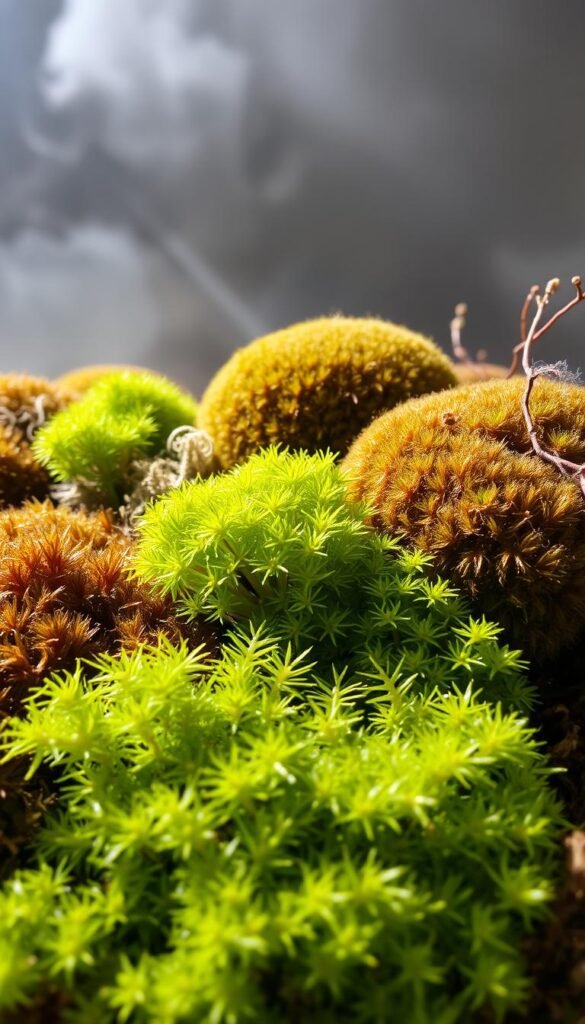
Discover the art of choosing nature’s softest carpets—organisms that transform glass containers into miniature ecosystems. With over 12,000 varieties worldwide, your success starts by matching species to their preferred growing conditions.
Exploring Moss Varieties and Their Needs
Four standout types thrive in contained spaces. Leucobryum glaucum grows in spherical clusters resembling pom-poms, perfect for adding dimension. Its silver-green hue deepens when hydrated, signaling ideal moisture levels.
Dicranum varieties cascade like miniature waterfalls, their feathery leaves recovering quickly after brief dry spells. Thuidium tamariscinum mimics fern foliage, creating layered textures that evoke woodland floors. Hypnales spreads horizontally, forming seamless emerald mats across surfaces.
Matching Species with Humid Environments
Prioritize mosses native to shaded forests where humidity rarely drops below 70%. These species evolved under tree canopies, making them naturally suited for terrariums. Avoid varieties that grow on sunbaked rocks—their need for airflow clashes with enclosed spaces.
Look for these moisture-loving signs:
- Velvety leaf surfaces that trap water
- Translucent stems visible when hydrated
- Slow growth patterns (less than 1″ monthly)
Pair sheet moss with cushion types to create visual contrast. Your forest floor recreation will maintain its vibrant greens when species share similar humidity needs.
Preparing the Perfect Environment: Soil, Water, and Light
Creating the ideal home for your green companions starts with understanding their natural preferences. These ancient organisms thrive in conditions that might surprise traditional gardeners—think forest floors, not flower beds.
Choosing the Appropriate Substrate
Forget rich potting mixes. Your green carpet prefers compact, nutrient-poor foundations like baked clay chunks or aged bark. These materials mimic decaying logs where moss naturally anchors itself, providing stability without excess fertility.
Clear existing vegetation thoroughly. Gently scrape away grass or weeds using hands or a plastic tool—chemical removers leave harmful residues. A clean slate prevents competition for moisture and light.
Maintaining Consistent Moisture Levels
Think of hydration as a soft blanket, not a flood. Use a mister with fine droplets or a drip system set to 15-minute daily cycles. This gentle approach prevents displacement while keeping surfaces evenly damp.
Position displays where light filters through sheer curtains or tree branches. Most varieties flourish in 2-3 hours of indirect morning sun. Watch for browning edges—they signal too much direct exposure.
Step-by-Step Guide to Planting Your Indoor Moss Garden
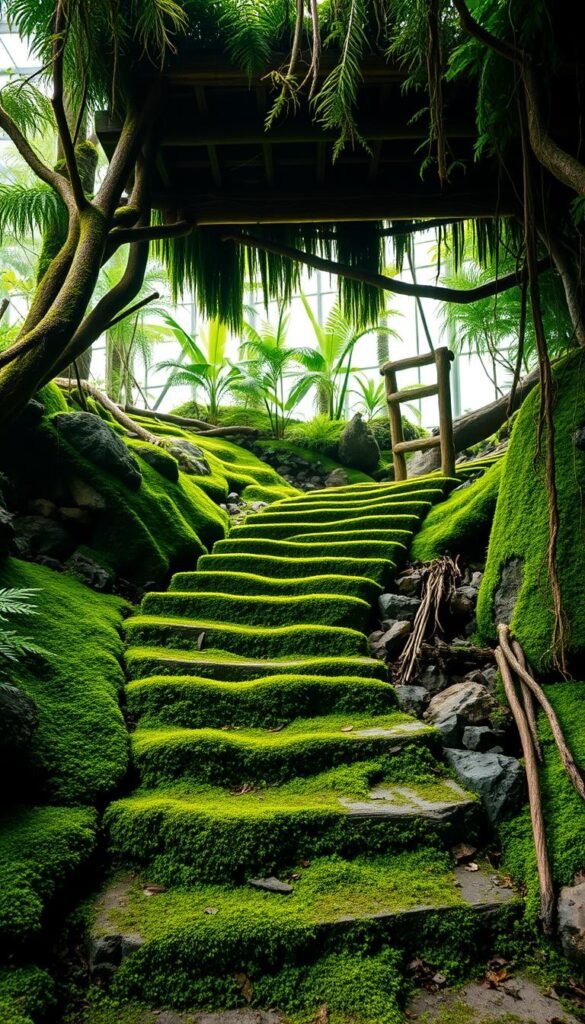
Transform your space with living art that grows softly under your care. This hands-on process blends creativity with science, letting you craft miniature ecosystems through simple techniques. Whether you’re designing a tabletop scene or a vertical installation, each step brings you closer to nature’s quiet magic.
Gathering and Prepping Your Materials
Start by sourcing healthy specimens from nurseries or ethical foragers. Always verify collection permits if gathering wild varieties. Rinse your finds in lukewarm water to remove dirt, then soak them briefly to dislodge hidden debris. Patience here prevents pests later.
Choose between two methods: instant impact with live clumps or gradual growth using a slurry mix. Blend fragments with buttermilk until it resembles green paint—this spreads spores evenly across surfaces like wood or stone. Let cleaned pieces air-dry for 20 minutes; they should feel damp but not dripping.
Keep these tools handy:
- Soft-bristle brush for gentle cleaning
- Tweezers to position delicate sections
- Spray bottle filled with filtered water
Press prepared clumps firmly onto your chosen base, misting as you work. For slurry applications, use a craft brush to “paint” tricky crevices. Both approaches thrive when you maintain consistent moisture and indirect light—your green canvas will flourish in 4-6 weeks.
Indoor Moss Garden: Achieve a Lush, Verdant Look for Humid Spaces
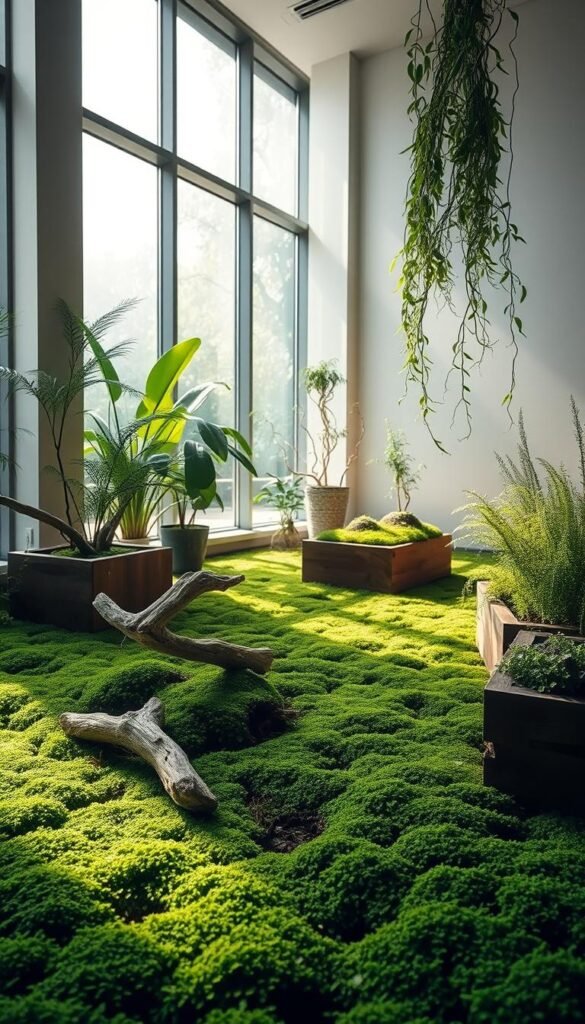
Merging centuries-old wisdom with cutting-edge science unlocks new possibilities for living decor. Japanese gardeners perfected Kokedama—suspended moss spheres—over 500 years ago, while wartime medics harnessed Sphagnum’s natural antiseptic powers. Today, these time-tested methods meet smart sensors and tailored substrates, reshaping how we nurture green sanctuaries.
Bridging Past and Present in Plant Cultivation
Your space benefits from both worlds. Traditional ikebana principles guide composition, ensuring harmony between textures and forms. Meanwhile, digital hygrometers track moisture levels, alerting you before delicate fronds dry out. This blend preserves aesthetic intent while boosting survival rates.
Modern gardening tools solve historical challenges. LED panels mimic dappled forest light for species needing precise illumination. pH-balanced misting systems replace guesswork, maintaining ideal conditions even in arid climates. Yet the soul of these creations remains rooted in simplicity—a single moss ball still captivates like it did in Edo-era tea houses.
Scientific breakthroughs reveal why ancient practices worked. Researchers now understand how certain species release antimicrobial compounds, explaining their historical medical use. This knowledge lets you select varieties offering both beauty and air-purifying benefits. Your display becomes a living bridge between eras, thriving through shared human ingenuity.
Designing a Captivating Indoor Moss Landscape
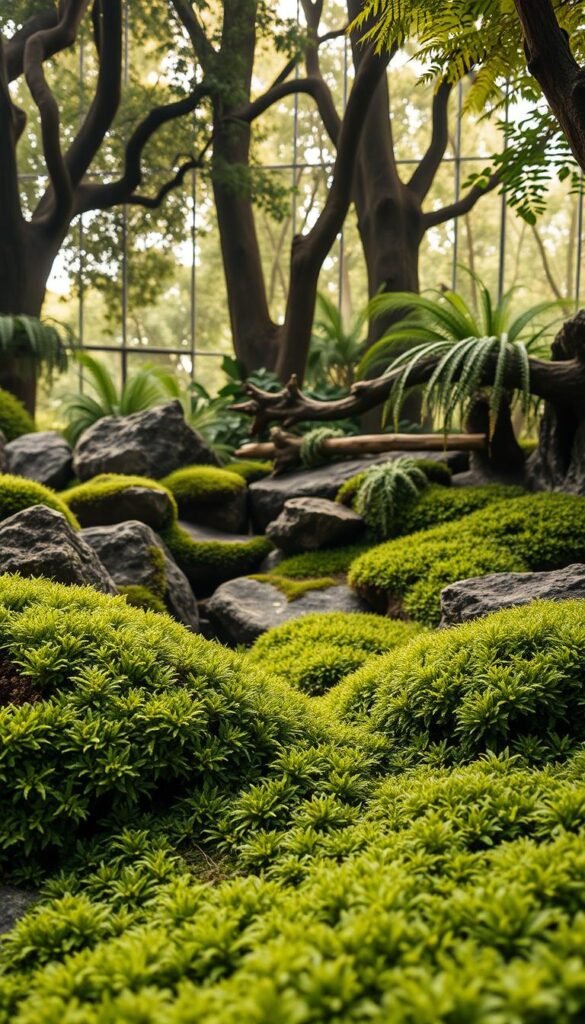
Crafting an eye-catching display starts with understanding nature’s geometry. By blending organic shapes and strategic placements, you build living compositions that feel both wild and intentional. Let’s explore how to transform basic elements into scenes that spark wonder.
Arranging Natural Elements for Visual Impact
Think of stones as your composition’s backbone. Angular slate pieces create dramatic ridges when partially buried in velvety growth. Pair them with smooth river rocks to establish rhythm and balance. Rotate wood pieces until their curves mimic natural wind patterns—this tricks the eye into seeing age and authenticity.
| Element | Function | Design Tip |
|---|---|---|
| Rocks | Anchor points | Bury 1/3 for realism |
| Wood | Vertical interest | Use weathered bark |
| Water Features | Humidity source | Mini pebble ponds |
Creating Depth and Texture with Moss
Layer feathery fern moss over cushion varieties to simulate forest floors. The height differences catch light uniquely throughout the day. “Texture isn’t just felt—it’s seen through shadow play,” notes landscape artist Mara Lin. Add sheet types around miniature bridges or benches to soften edges and invite touch.
For fairy garden magic, cluster star moss near tiny structures. Its radial growth pattern mimics flower beds at scale. Darker species near pathways create natural borders, guiding the gaze through your tiny universe. Remember—contrast thrives where plush meets rugged.
Maintenance and Care for a Thriving Moss Garden
Your living artwork stays vibrant through gentle, consistent care practices. Unlike fussy houseplants, these green wonders ask little but reward generously when their basic needs are met. Think of upkeep as mindful moments rather than chores.
Balancing Light and Hydration
Use distilled or rainwater for misting—tap water’s minerals can dull leaf surfaces over time. A light spray twice daily maintains moisture without drowning delicate structures. Watch for dew-like glisten: that’s your cue to pause.
Position displays where morning light filters through curtains. Rotate containers weekly to ensure even growth. If edges brown, shift farther from windows. Stable temperatures between 60-75°F mimic their native forest floors perfectly.
Fertilizing? Less is more. A diluted seaweed solution every 6 months fuels growth without overwhelming. Pull stray weeds gently to protect root-like rhizoids. Your main task? Enjoy the quiet transformation as seasons reshape your miniature Eden.

